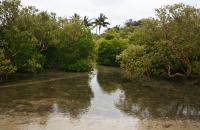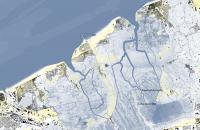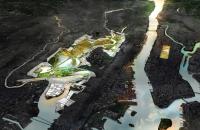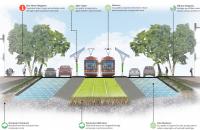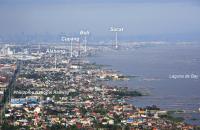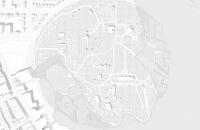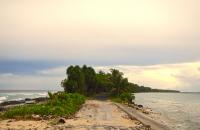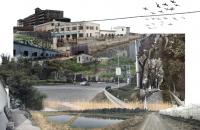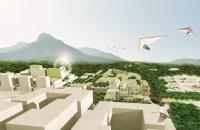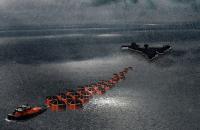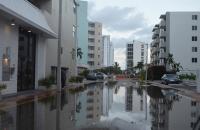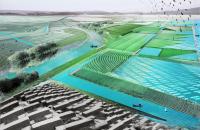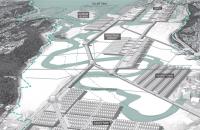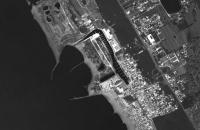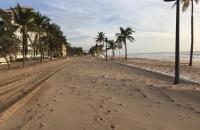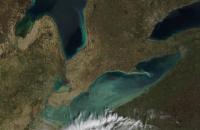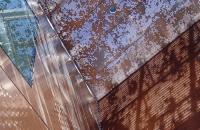Professor in Residence, Department of Architecture, GSD, Harvard University, Cambridge MA, USA
Issue's articles
An Urgent Task Ahead
VOLUME 2/2017 - Issue 2 [RESILIENT EDGES], Pages: 157 - 159 published: 2018-02-08The Resilient Metamorphosis of Cities
VOLUME 2/2017 - Issue 2 [RESILIENT EDGES], Pages: 161 - 165 published: 2018-02-08Waterscapes in Transformation: The Case of the Belgian Coastal Area
VOLUME 2/2017 - Issue 2 [RESILIENT EDGES], Pages: 743 - 766 published: 2018-02-05The socio-economic impact of nature in Belgian coastal landscapes on a regional scale is high due to their general attractiveness for visitors, their strongly developed tertiary service economy and other related sectors (tourism, residential, agriculture…). Due to climate changes however, these coastal landscapes and their required accessibility and continuous character are threatened by the unavoidable planned infrastructures (dikes, new connections, floodable areas, etc.) that will generate ruptures, frictions and additional transition spaces within the landscape. Flanders urgently needs to unfold policies and strategies to avoid or reduce the undesirable effects of the expected changes. Influential changes for the coastal zone will be sea level rising, increasing temperature, changing rainfall patterns, floods, fragmented ecological system, salinization, and reduced drainage capabilities to sea. A thoughtful planning policy forms the necessary key to a sustainable development. Policies and plans lead to the formulation of spatial proposals for mitigation and adaptation, to be executed by major infrastructural works planned for the next decades. Most of these infrastructures, conceived at a large scale, generate a different model of accessibility for the Flemish Coastal landscape.
Climate Change Adaptations for Coastal Farms: Bridging Science and Mātauranga Māori with Art and Design
VOLUME 2/2017 - Issue 2 [RESILIENT EDGES], Pages: 497 - 518 published: 2018-02-06Indigenous coastal farming communities need to address future climate change impacts, yet many communities are slow to respond, due to lack of adequate information, economic pressures, the abstract nature of climate change science and poor communication between what science knows and what indigenous farming communities need to know. Art and design can address these issues by synthesizing broad scientific principles with local place-specific culture and their visual language can effectively communicate short and long-term benefits to local communities. Art and design are thus both generative research methods and media for representation. This research uses art and design to provide a bridge between the Māori culture of a local farming community in coastal New Zealand and climate change science. It provides a framework of strategies for new farm practices. Underpinned by the qualitative awareness of thresholds and an open-ended toolbox of land-based strategies, the role of the framework is to catalyze adaptation. The framework is responsive to both the Māori worldview and scientific knowledge, and has the potential to provide a model for other coastal communities.
Challenges of Disaster Relief Housing: Evaluating Coastal Domestic Typologies in Eastern Sri Lanka
VOLUME 2/2017 - Issue 2 [RESILIENT EDGES], Pages: 601 - 628 published: 2018-02-06In the aftermath of the December 2004 tsunami, an unprecedented natural disaster that disproportionately affected the impoverished and conflict-ridden eastern coast of Sri Lanka, the outpouring of disaster relief and support for housing reconstruction was primarily led by international aid organizations for the erection of capital-intensive dwellings to allow for immediate habitation. Three case studies representative of significant housing typologies deployed since the tsunami are investigated: two global prototypes sponsored by foreign aid, and one informal, vernacular construction. We argue that in Sri Lanka the aid-housing-as-commodity paradigm - which in its specificity and immutability disregards the robust tradition of integration between natural and built environments and between individual and community - represents an increasingly and unsustainably risky expenditure of capital resources due to the likelihood of more frequent disasters in coastal zones. We argue for a shift toward spatial frameworks, not static prototypes, which take into account that the longer temporal dimension of rebuilding community and housing after a natural disaster is not necessarily synonymous with expensive, structurally robust building practice.
Salinas: Interstices of the Urban, Cultural and Political Processes in Mediterranean Ecologies
VOLUME 2/2017 - Issue 2 [RESILIENT EDGES], Pages: 707 - 719 published: 2018-02-06Salinas, or Mediterranean coastal salt marshes, are priceless ecological wetlands, resilient spaces along the coast that have survived over time and hold incalculable cultural, historical, and ethnographic values associated with them. Today, artisanal sea salt production is no longer a profitable business, and in many cases, these spaces become a no-man’s-land in-between nature and city, falling victims to pressures of changing land uses and the unsustainable urban growth of the Mediterranean coastal tourism. However, the process of change and abandonment of these former production landscapes presents an opportunity to promote new formulas for spatial tactics, public use and new sustainable futures. A liminal condition full of spatial and formal assets that opens the rising potential of the local economy and the right of the salina’s active exploitation, interaction and identification.
Fragile Edges and Floating Strategies along the Albanian Coastline
VOLUME 2/2017 - Issue 2 [RESILIENT EDGES], Pages: 685 - 705 published: 2018-02-06The essay investigates coastline development along the southern area of the Albanian Riviera, introducing the concepts of “landscape fragments” and “landscape within a landscape” as design methodologies. By speculatively reversing the order of landscape perception from land to water, the coastline becomes a flexible device capable of responding to unpredictable future events - natural disasters related to climate change (rising sea levels), or globally challenging socio-political phenomena (such as mass migration growing in scope, complexity and impact). The experimental design approach involves the design and representation of an incremental waterscape. By reversing the morphological perception of the coastal landscape and making a set of tactical selections in natural and artificial landscapes, the students highlighted the territory’s potential. With new awareness, they proposed site-specific interventions along the coast and inland, re-territorializing the “apparent tabula rasa” and demonstrating the coastline’s potential dynamic reaction to environmental challenges.
Mangroves of Maputo, Mozambique: from Threatened to Thriving?
VOLUME 2/2017 - Issue 2 [RESILIENT EDGES], Pages: 629 - 641 published: 2018-02-06Coastal wetlands worldwide are among the most productive yet highly threatened systems in the world, and are framed and protected by the Convention on Wetlands (Ramsar, Iran, 1971), of which Mozambique is a party since 2004 (IUCN, 1971). Maputo city coastline consists of an ample alluvial plane, where large extensions of mangrove forests occur within the city, namely the Costa do Sol wetlands, offering a wide range of ecological and economical services. Here, urban development pressure is increasing and rapidly changing dynamics are creating new urban settings, pressing in ecological sensitive areas of Maputo’s coastline. The functions of the still existing ecosystems and positive effects that these can have within the urban environment are relevant to be known and investigated in light of the greenway principles. Through the landscape architecture lens, insights on the service capacity of these mangroves in terms of conservation strategies, local perception, usage and management, and design possibilities are added, which can contribute to maintain and expand the high urban quality that is historically attached to Maputo city.
Between Land and Sea: Reshaping the Belgian Coastline A Case Study between Ostend and Blankenberge
VOLUME 2/2017 - Issue 2 [RESILIENT EDGES], Pages: 721 - 741 published: 2018-02-06Over time, the Belgian coast has developed into a hard-engineered straight defence line - from the sea inwards - of flat beaches, dykes and a storm wall that is reaching its capacity limits. New plans are being developed in some parts of the coast aiming to raise the storm walls up to “acceptable” levels, based on climate change and sea level rise predictions. This follows the trends of raising river protection walls, but continuously insists on the linear urban structure of the coastline: beaches, dyke, urbanization wall on the dunes and housing proliferation into the back polders. These are often low-quality holiday houses built for the summer season rush. This essay investigates an alternative future for the Belgian coast through research-by-design. The design exploration proposes to seize the opportunity of the increased peril, predicted from climate change and subsequent sea level rise. Furthermore, it proposes a shift from hard to soft engineering and a dynamic tidal landscape within which the tourism economy is reinvented.
“Polyvalent Adaptation”: Design in a Temporal Context of Uncertain High-Risk Futures
VOLUME 2/2017 - Issue 2 [RESILIENT EDGES], Pages: 185 - 209 published: 2017-12-21If greenhouse gas emissions ceased today, sea levels will continue to rise for centuries due to the time scale of climate change. This demands a fundamental shift from solely mitigating impacts to adapting to this new reality. Architects can play a key role but are often restrained by outmoded disciplinary norms, and financial and regulatory limitations.
What we require is a new design paradigm that extends beyond site-specific needs and draws on the context of our high-risk future. “Polyvalent Adaptation” could significantly impact the profession and the future of our communities. This approach combines two concepts that are not new to architecture or to discussions surrounding sustainability and climate change, but, when married, amplify each others’ potential. Combining the temporal concepts of polyvalence and adaptation provides a new lens for tackling the conflict between the permanence of the built environment and the changing climate. From this perspective, projects can be designed and constructed to meet current needs, to provide projective agency capable of assisting in the aftermath of extreme weather, and to become support infrastructures for new settlement patterns.
(Geo)Design Coastal Cities: Design with Data (and Nature too)
VOLUME 2/2017 - Issue 2 [RESILIENT EDGES], Pages: 337 - 366 published: 2017-12-20The geography of a coastal city, such as its native geological, biological, and physical conditions, plays an important role in understanding the impacts of climate change upon the area. To better identify strategies for adaption to global climate change, planners and designers need better tools and techniques to learn and analyze the geographical context of their cities on coastlines worldwide. This article describes an urban design studio conducted in the spring of 2014. Students in this class explored the future of North Carolina coastal cities in light of rising global sea level. Geodesign using GIS and other visualization tools enabled the students to focus on urban morphology, development patterns, and environmental characteristics of the city in order to identify new interventions that can support a new set of relationships between urbanity and nature.
Resilient Edges: Exploring a Socio-Ecological Urban Design Approach in Metro Manila
VOLUME 2/2017 - Issue 2 [RESILIENT EDGES], Pages: 519 - 561 published: 2017-12-21With the notable uptick of natural disasters impacting densely-populated areas, attention to the subject of urban resilience has increased among ecologists, economists, engineers, social scientists, and designers. But despite an extraordinary cross-disciplinary interest in a single subject, the urban resilience discourse has remained largely siloed by discipline. This essay builds on concepts of resilience from ecology and social science and positions urban design (in itself at the intersection of architecture, planning, and landscape architecture) as uniquely situated for integrating and operationalizing various concepts of urban resilience. The authors propose a socio-ecological urban design approach that bridges natural, human, and spatial systems and is empirically grounded in historical research, field observations, and interviews with informal settler families (ISFs) living along the shoreline of Laguna de Bay in Metro Manila. The findings revealed that while many were affected by regular flooding and issues of housing security, these were not necessarily deciding factors when determining where to live. In response to programs which emphasize out-of-city relocation, authors developed three principles of urban resilience that instead spatially integrate formal and informal communities.
Other Than Infrastructure: Leaving Room for the Fantastical in the Resilient Project
VOLUME 2/2017 - Issue 2 [RESILIENT EDGES], Pages: 167 - 184 published: 2017-12-21The manuscript reflects on the delightful and absurd qualities that might be harbored in routine infrastructures. Through a series of contemporary and historical examples the paper highlights how experience, material quality, narrative, and civic engagement can unlock new potentials in the mundane, and often intangible systems, which are intended to protect and serve those in flood prone territories. Understanding first that resilient water-management infrastructures exist along a spectrum of defense, and second that they each participate in their own extensive system of flows and processes, generates a set of opportunities for designers to interject and draw out new possibilities. Locating projects within these systems calls for two approaches:
1. identifying the “objecthood” of infrastructure; and 2. techniques for “unblackboxing” or bringing parts of now hidden systems to the foreground of the civic realm. The paper suggests that these two approaches aid in locating the whimsical within systems and offer calculated ways to confront flood mitigation methods that all too often privilege what is deemed as efficient over what is enjoyable.
Interrupted Atolls: Riskscapes and Edge Imaginaries in Tuvalu
VOLUME 2/2017 - Issue 2 [RESILIENT EDGES], Pages: 287 - 321 published: 2017-12-20Climate change puts the edge between land and sea in sharp relief; sea level rise is essentially a condition of drifting littoral edges.As rising seas threaten to encroach on land-based territories, cities and nations have responded by attempting to fix the edge at a moment in time, blocking the sea’s insidious creep. Atolls formed by coral reefs are mobile, living geographies, which resist attempts to harden their perimeter through structures such as seawalls. We explore how ideas and imaginaries associated with the “edge” between sea and land in the atoll-nation of Tuvalu illustrate competing “riskscapes” and objectives associated with the actors involved. This essay explores this interplay between politics, aid, technocratic solutions, media representations, global aspirations, local ambitions, and climate risk in Tuvalu through an examination of past/future seawalls and other proposals (realized and unrealized) for controlling atoll edges. Through the cases, we seek to re-politicize the edge, unpacking the difficulties surrounding adaptation issues in small-island states, and explore alternative models of “resilient edges” for atoll-dwellers living with climate changes.
An Eco-Leap Forward: Shifting Agriculture
VOLUME 2/2017 - Issue 2 [RESILIENT EDGES], Pages: 563 - 583 published: 2018-02-06Human activity has been changing the surface of the earth for several thousand years. In recent decades, the rate of change however was accelerated in the Yangtze River Delta, propelled by China’s rapid and continually chaotic process of urbanization and industrialization. How can our cities eventually face haze, water pollution, soil contamination, and natural disasters caused by climate change? The challenge is indeed to explore how to achieve an ecological resilience by enhancing biodiversity and by reviving and revising productive landscape.
Cidade Oceanico. Environment and Urbanization in Rio de Janeiro
VOLUME 2/2017 - Issue 2 [RESILIENT EDGES], Pages: 439 - 459 published: 2017-12-20Using Rio de Janeiro as a case study in urbanization within the context of climate change, this multi-year urban design studio examines the challenges of addressing rising sea levels in one of Latin America’s largest cities. As a coastal metropolis, Rio requires that heterogeneous networks be woven between ecological and 21st century urban design processes. Yet, Rio continues to grow in low-lying, ecologically sensitive areas - and this has been exacerbated over recent decades by mega-event driven development coupled with inter-dependent informal urbanization. These forces characterize Zona Oeste, the focus area of the design initiative. This essay reflects on an international urban design pedagogy that seeks to integrate strategies to address climate change, rising sea levels, and unpredictable growth. Inherently, this project opens up a discussion into many sensitive questions regarding historical and cultural responsiveness. Filtered through the work of Lucio Costa, his proposals for Baja da Tijuca, and opportunities to re-engage the legacy of a modernist plan, students engage this rich context through a discursive design prompt with implications for both pedagogy and practice within and beyond Rio de Janeiro.
The SEA Is Coming: The Future of a Marine Research Facility
VOLUME 2/2017 - Issue 2 [RESILIENT EDGES], Pages: 415 - 438 published: 2017-11-21This paper originates from a Louisiana State University School of Architecture Research Studio. Charged by the organization’s Director, the students investigated the Louisiana Universities Marine Consortium (LUMCON) facility and environment, and re-imagined both the building and landscape as a cutting-edge (albeit remote) research and educational destination. “The SEA Is Coming” Integrative-Design Studio proposes adaptation to climate change as a means to investigate the transformative capacity of a site. Going far beyond the boundaries of current (and future) building program, the studio method provoked profound rethinking of current conventions about coastal change and occupancy, design, community, the environment, and land use. LUMCON’s facility sits at the nexus of deltaic land, freshwater, brackish wetland, and salty ocean and provides access to all these systems. It has withstood the volatility of this environment: flooding, hurricanes, oil spills, the Gulf dead zone, salt-water intrusion, etc. Now over thirty-years-old, the building must adapt to changing conditions. The studio investigated LUMCON’s ability to continue functioning in its changing environment and further its indispensable research capabilities of the rapidly changing coastal landscape.
MaterialNature: An Opportunistic Paradigm of Architecture and Landscape Ecology
VOLUME 2/2017 - Issue 2 [RESILIENT EDGES], Pages: 229 - 242 published: 2017-11-21In this space, small-scale coastal erosion, and natural growth become the vehicle for project based architectural speculation that leverages the resources of local landscapes and creates a new architectural trajectory based upon the need and aesthetic of ecology. Here, MaterialNature is a series of architectural entities that become landscapes over time, made from a mixture of residual materials designed specifically to be weatherized. Its design is intended to provide a potential architectural amenity in areas of recreational activity as well as areas devoid of human contact, while simultaneously realizing a potential for architecture to be born from waste or local material, and to return to nature without providing further waste. As such, this architecture moves from one of formal composition to one where the formal characteristics of local ecology and landscape become more apparent than the form itself.
Miami Rising: Historical Perspectives on Sea Level Rise as a View into the Future
VOLUME 2/2017 - Issue 2 [RESILIENT EDGES], Pages: 367 - 387 published: 2017-11-15Miami is a city whose diversity and vibrant growth has made it an ideal destination for international travel, business, and leisure. However, South Florida is a hurricane prone region, and the threat of sea level rise and erosion poses an immediate and long-term risk to the stability of the city and its region. The city and the scientific community have been studying the phenomenon for some time now, proposing solutions to the management of such threatening uncertainty. Yet the quest for coastal resilience is not a new phenomenon. Since ancient times human settlements have entertained a complex relationship to the water. This paper will explore how several cities throughout history have dealt with flood resilience challenges and consider how historical attempts to adapt and address such problems can provide new spatial strategies for Miami’s future. Aware of the fact that such a study cannot reveal technical solutions for the twenty-first century, the emphasis will be given to an understanding of the correlation between socio-economic identity, attitude towards defensive action, and the type of organization needed for concerted action.
Connecting Water Resources across Political Borders: A Pearl River Delta Special Ecological Area
VOLUME 2/2017 - Issue 2 [RESILIENT EDGES], Pages: 585 - 599 published: 2017-11-14Situated between several interdependent political and economic zones of southern China’s Pearl River Delta, the Pearl River Delta Special Ecological Area (PRD SEA) project explores the possibility that regional administrative boundaries could be softened and redrawn along ecological boundaries. With the advent of global sea level rise and its impact on the fragile fresh water ecology and huge population of the Pearl River Delta, the project proposes novel ways to share fresh water and wastewater across political zones to better administer and profit from the distribution of water resources.
Climate change, urbanization, and pollution from industrial and agricultural development threaten the steady supply of fresh water to the Pearl River Delta and its cities, while population growth in the region only increases demand. At the same time, Hong Kong, Macau and Shenzhen’s increasing economic, political and cultural interdependency presents the possibility to tackle these challenges holistically. Layering a regional water resource infrastructure onto existing and new industrial, residential, agricultural and transportation armatures would transcend borders and create new economic markets through ecologically sustainable practices.
Groundedness as Risk: Adaptive Strategies for Ground Failures in Seattle
VOLUME 2/2017 - Issue 2 [RESILIENT EDGES], Pages: 295 - 317 published: 2017-11-13“Groundedness” implies stability and permanence, but our reliance on the presumed fixity of the earth under our feet has led us to lose sight of its dynamism. From macro tectonic readjustments to micro sediment transport, these natural processes are part of an adaptive cycle that oscillates between stasis and destruction. Urban development, predisposed to Engineering Resilience, has exacerbated disasters by attempting to fix and control ground without considering the recombinant and indeterminate systems of Ecosystem Resilience. Seattle is the largest city in a region due for its “Next Big One” - a megathrust earthquake in the Cascadia Subduction Zone. This high-magnitude perturbation would occur in an urban context already sensitive to geologic risks. A history of land manipulations has affected Seattle’s ground equilibrium, making it more susceptible to natural disasters. The urgency of the impending risks has inspired adaptive design that foregrounds action as a means of developing a disposition. A catalogue of strategies is applied to a masterplan that balances “sediment” as a resource that builds resilience to ground hazards and promotes ecosystem health.
Design Strategies and Non-Standard Territories. The Resilience of the Domitian Coastline
VOLUME 2/2017 - Issue 2 [RESILIENT EDGES], Pages: 669 - 683 published: 2017-11-10Coastal areas are an extraordinary condition for research and investigation, at a scale encompassing multiple landscapes that underwent a massive transformation, leading to their current crisis state. A landscape with different degrees of depth, with complex conditions and rules of the spatial systems that can be fully understood only through an accurate selection and study of the elements that concurred to its creation. The natural cycle that built the different elements of this landscape is definitely an element to take into account during the definition of the design strategies: through the alluvial deposit first and marine next, it “built” the shore, the dunes - a natural protection against the sea-water level rise - and the pinewood behind the dunes. Our goal is strategy that, recovering and recycling the ancient and pre-existing dialogue between the form of the city and the form of the landscape, recovers and recycles that long and natural resilience process: a quality those areas always had, considering also the potential rising of sea levels.
Salty Urbanism: Towards an Adaptive Coastal Design Framework to Address Sea Level Rise
VOLUME 2/2017 - Issue 2 [RESILIENT EDGES], Pages: 105 - 130 published: 2017-11-09Utilizing the North Beach Village neighborhood in Fort Lauderdale, Florida, as case study, “Salty Urbanism” establishes an interdisciplinary team to develop a coupled research methodology and pedagogical approach that envisions and quantifies the experiential and ecological outcomes of alternative ways forward for the neighborhood in response to climate instability, disruption and rising sea levels. These outcomes consider an inevitable future of saturated landscapes and, as a result, integrate research models that accommodate a variety of best management practices (BMP), low impact development (LID), green infrastructure (GI) and other alternative concepts to be implemented over time in the neighborhood adaptation plan.
Water-Born Micro-Cities: Bringing the Great Lakes Closer to Natural Symbiosis with Eco-Based Design
VOLUME 2/2017 - Issue 2 [RESILIENT EDGES], Pages: 87 - 104 published: 2017-11-09Through design-based research, we investigate how a water-borne micro-city can participate in ecological repair that also supports healthy, human life by removing harmful algae from the water and utilizing it as a supply resource for energy. In this proposed scenario, urbanism becomes the active component in prevention of toxic algae blooms. By bringing together scientific research with research from medicine, design, history and social science, we begin to animate design strategies that promote local and regional resiliency within the Great Lakes. These hypothetical designs, while focusing on algae within the Great Lakes, can provide a feasible prototype for other coastal regions around the world. The priorities of this project are relatable to all coastal-adjacent settlements and the pending depletion of resources that will jeopardize human life.
Integration of Habitat Grammars for Biodiverse and Resilient Coastal Structures
VOLUME 2/2017 - Issue 2 [RESILIENT EDGES], Pages: 211 - 227 published: 2017-11-09Contemporary architectural ornament serves multiple purposes; articulated surfaces are no longer simply symbolic gesture but, in addition, contain material performance as expression of technological, environmental and other cultural factors. At the same time, parametric design has opened new frontiers in patterning and bio-inspired design.
The manifestation of these bio-inspired materials can be compelling spatial narratives that speculate on the blending of nature and architecture. However, these biophilic tendencies might further serve in the development of more sustainable architecture and urbanism; surfaces and structures derived from nature might also serve nature.
In this work, we present a method to define “habitat grammars” that create functional spaces for diverse species, as well as generating unique aesthetic properties derived from regional nuances in flora and fauna. The method is applied to a seawall in South Florida near mangroves. Panels were cast in high strength concrete and experimentally observed in aquariums with live specimens. The results indicated that low relief panels performed equivalent to featureless walls, whereas higher relief panels elicited a near unanimous response from the introduced species.






